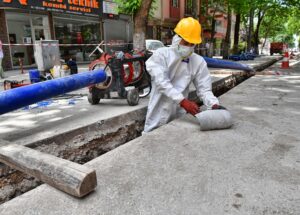In this article, we take a look at the countries around the world where asbestos is still a medical problem, reflecting on the widespread asbestos ban that occurred in the 1980s…

Photo by SELİM ARDA ERYILMAZ on Unsplash
Being diagnosed with an asbestos-related condition can be devastating as often exposure to asbestos can cause severe and fatal diseases. Those who are victims of such circumstances can pursue some form of legal claim such as an asbestosis compensation claim.
There are several illnesses that can occur from exposure from asbestosis, two common conditions include mesothelioma and asbestosis. Both conditions cause huge medical defects and can both lead to fatality, even with treatment.
According to Asbestos Nation, 55 nations around the world have banned asbestos from the European Union and the UK to Japan and South Africa. Despite the serious health risks posed by asbestos exposure, there are still many countries that still use the material. Let’s delve into more details…
Where is Asbestos Still a Medical Problem?
Back in the 1980’s there was a wide-spread asbestos ban, yet several countries chose to oppose it (some of them you may find shocking!) Naturally asbestos-related illnesses are still a huge medical problem in these places. A few of the countries that have avoided the asbestos ban to date include:
USA
Research shows that ‘more than 39,000 American lives are lost to asbestos-related disease every year.’ Whilst the USA does pose restrictions on asbestos, the mineral is not banned entirely.
In the past, there have been a few attempts to introduce laws that ban asbestos, yet the legislation has always failed to pass Congress. Back in 1989, the EPA decided to ban over 90% asbestos containing products.
The ban was later overturned on the basis that, ‘it was too costly and that the alternatives were neither safer no more effective than asbestos.’
Russia
In Russia, the estimated yearly death toll for asbestos related conditions is 10,400 cases.
The UN has attempted to give asbestos the label of an ‘extremely hazardous’ commerce product.
However, Russia and several other countries have blocked their attempts to do so.
While many other nations ban the substance, Russia is in fact known to support the growth of the asbestos market.

Photo by Olga Kononenko on Unsplash
India
India uses large amounts of asbestos and in many sectors the product does not include any health warnings. Along with Russia, India chose to prevent the UN from imposing health warnings and restrictions on the product.
Since back in the 60s India has used approximately ‘7 million tonnes’ of asbestos in its buildings. It is difficult to assess the scale of the medical problem, as India has a lax system for tracking the asbestos-related diseases.
China
China is known as one of the largest asbestos producers, mining over ‘450,000 metric tons in 2000’. Asbestos-related conditions and fatalities are a huge medical issue in China, and experts believe that the problem is growing.
According to the European Agency for Safety and Health at Work, the mesothelioma death toll in China could reach, ‘15,000 by 2035’.
Brazil
Back in 2017, asbestos was banned in Brazil, including the marketing, distribution, mining, and processing of the substance. At the time, those who wished to continue using asbestos started to rebel against the rules. Those who opposed the ban hoped that they could carry on exporting the mineral. In May 2019, legislation was introduced to re-approve chrysotile asbestos export and mining.
The country’s involvement with the asbestos industry is believed to be causing a surge of cancer-related deaths. Brazil exports chrysotile to various Asian countries, which are also experiencing high death rates from asbestos conditions.
What About the Countries That Have Banned Asbestos?
While banning asbestos is a responsible decision for public health, by the time the bans were instated, much of the damage had already occurred. According to The Lancelet,
“The lengthy latency period of asbestos-related malignant diseases—in some cases more than 40 years—means that even in countries that no longer use the material, the disease burden continues to rise.”
The UK banned every type of asbestos in 1999, yet health and safety data suggests that asbestos still kills 5,000 people in the UK every year. There is still a risk to those who work on old buildings as they’re likely to still contain asbestos.
According to the HSE Asbestos Related Disease Stats Report 2021, as a result of asbestos exposure prior to 1980, we can expect the current levels of asbestos- related illness to continue, ‘for the rest of the decade’.
Iceland was the first country to ban asbestos, back in 1983, and yet sources show that asbestos -related deaths are still on the rise. Researchers discovered that since 2014, the number of mesothelioma deaths in Iceland have been increasingly rapidly.

Photo by Etienne Girardet on Unsplash
Do Asbestos Bans Work?
Though asbestos is still a medical problem in countries like the UK and Iceland, experts suggest that asbestos bans will work. However, the process may take some time. With such high exports of asbestos, and so many buildings containing the mineral, it is difficult to predict when we can expect to see a decrease in asbestos related conditions.
Regardless, countries that have taken steps to band the material fare better for the future. In countries like Russia and India, where the asbestos industry keeps growing, it seems unlikely that asbestos will never cease to be a serious and escalating medical problem.
Asbestos is Still a Large-Scale Medical Problem
Since asbestos was only banned in the 1980s, it is still likely to be a medical problem in nearly every country, whether that country chose to ban the material or not. However, countries that chose to ban the substance, can expect to see a decline in asbestos-related conditions in the distant future.
Our only line of defense against asbestos-related conditions is to ensure that individuals who are working with the material are using the correct protective equipment to keep them safe.
Protection from asbestos may also involve removing older apparatus and appliances from our homes, for example, old boilers, furnace ducts, door gaskets or roof siding.
As years go by, we look forward to asbestos becoming less of a medical problem, for those countries that have instated the ban. We hope that the UN will continue to encourage opposing countries, such as Russia and India, to restrict and ban the material.

















